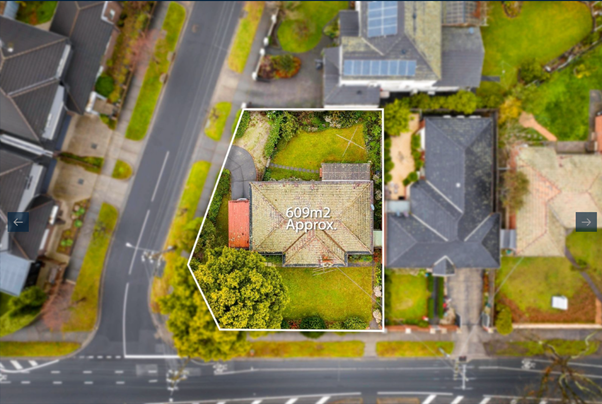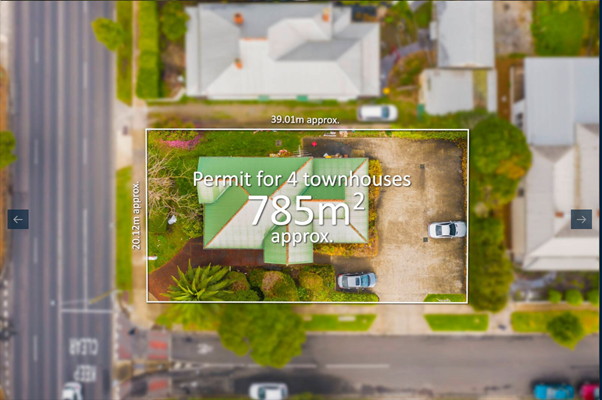Why Corner Sites are More Valuable?
Are you curious about why corner sites in real estate are considered more valuable? Wondering how this impacts property development and investment strategies? This article, based on years of development experience, provides a comprehensive analysis for property developers and real estate investors. Learn about the four key reasons that elevate the value of corner sites and how they can influence your investment decisions, as well as problems that devalue the site that you should avoid.
7 min read
Are you intrigued by the higher market value of corner sites in property development? You're not alone. My experience purchasing a site at Southern Road, Heidelberg Heights, is a case in point. The site, approximately 570sqm in size, commanded a price comparable to standard sites of around 680sqm.
Understanding the value of corner sites is crucial for several reasons. Whether you're aiming to make a savvy investment, assess the impact on the final sales price of a development, or determine the best sites for land banking, knowing these factors is essential.
Several years after completing the Southern Road project with the assistance of LLL Development, we've identified four key reasons behind the unique value of corner sites. This blog will delve into these reasons, offering valuable insights for property developers and investors.
What are corner sites?
Corner sites generally refer to sites at a street corner, where there are two sides facing roads.
Here’s some examples:
Example 1 - https://www.rtedgar.com/property/60a-bulleen-road-balwyn-north-vic-3104/55610/#lg=1&slide=0
Example 2 - https://www.rtedgar.com/property/453-station-street-box-hill-vic-3128/52280/#lg=1&slide=0
At times, we also refer to sites with one side immediately adjacent to a public park, laneway, and the like as corner sites. These sites may not fully gain all the benefits in the four reasons below, however, these sites may have part of the corner site benefits that can add value to your development.
Knowing the reasons help you value any additional benefits that you may help your purchase a better site.




four reasons why corner sites are more valuable
1. The New Houses you build are More Valuable
Street frontage and the sense of ‘my home, my castle’ have additional value.
Buyers of your new homes will see additional value if the new homes have their own street frontage, their own driveway, and the buyers don't have to share with neighbours, giving them a much better sense of ownership.
Speak with your real estate agent for your particular suburb, and they will be able to tell you more about the actual likely additional price per dwelling in your specific suburb, as every suburb is different in how much value the street frontage has.
For example, as of Year 2023, one of the popular eastern suburbs around 20km from Melbourne (with a reasonable front garden) may add an extra $150 - $200k to the sales price. Whereas another suburb roughly 15km in the north side of Melbourne will worth an extra $30k.
As our real life example, in one of our three-unit developments at Heidelberg West on a standard site (not a corner block), we sold:
Front house - $690k
House in the middle – Unimportant in this article
Rear house - $700k
The rear house is roughly 15% larger than the front house because it occupies the width of the site, gaining an extra 30 sqm on the ground and the first floor combined.
Based on those numbers, the street frontage is worth roughly $30k extra.
In this example, if you have all 3 units each with their own street frontage in that suburb, you potentially created two more units with frontage each worth an extra $30k more.
2. You get more buildable areas
Where a building faces the street, you can often push for more building bulk. This means you can build more building areas. With two street frontages, it means you are able to push for more building area on two sides of your site.
Depending on different councils, sometimes you are allowed to build more building bulk facing a laneway, adjacent to a public park, or adjacent to other public spaces such as railway lines or the like.
What that means to you is, you have more building areas to fit bigger townhouses, or if you can use the extra space to build an extra unit.
You will need to do your market research at the start and tailor the new dwellings to what the market wants in order to create maximum profit or opportunity. Some suburbs, such as the eastern suburb in Melbourne, are willing to pay an extra $250k or more per dwelling from a small 4-bedroom house to a larger 4-bedroom house.
Whereas say in the northern suburb of Melbourne, you may want to build an extra unit with the additional space that you have, as larger houses do not increase the sales price justifying it’s size, as of Year 2023.
If you want to work with an architect that will consider these factors and maximise your profitability, all you need to do is give us a call.
3. The new house sells faster
Often, townhouse purchasers have these questions in their minds. If you can eliminate these questions, your new dwellings will sell faster.
These questions are:
How good are my neighbours on the same site?
How much time will it take me to deal with the neighbour? And
How to maintain the common properties within the site.
These questions are common for ‘inexperienced purchasers’, and most townhouse purchasers are ‘inexperienced purchasers’... that is, this is either their first home or second house purchase in their life.
With ‘inexperienced purchasers’, it means simple things, such as:
‘just call the body corp’ or
‘just knock on the neighbour’s door, find a contractor to check the pipe and split the bill with your neighbour’...
can be a major hurdle in the purchaser’s mind.
For you, as the property developer, you may be making 5 of these phone calls a day and it’s just easy. For the purchasers, it can be the hurdle between putting in an offer, or buying the other development that does not have to deal with neighbours when a common property needs repair.
So, when purchasers ask ‘will the body corp keep increasing over the years? What happens if the pipe is blocked?’ type questions...
Your real estate agent will tell you the best answer would be... ‘Mr. Purchaser, you don’t need a body corp. You only pay a few hundred dollars a year to maintain the entity, because there is one oversized pipe under common ownership that is impossible to damage.’
4. Lower Risk
The idea of town houses value better was discussed above. But did you know that town houses facing the street are rarer than town houses not facing the street? And generally (suburb dependent) town houses facing the street have more demand?
What does that mean for you? It means:
When the market is going well at the time you sell the new town houses, you can ask for more money than the others.
In an average seller’s market, you can sell the new town houses faster. Imagine saving you 3 months of interest cost on a $1.8 million dollar bank loan.
And in a bad seller’s market, you are more likely to sell your town houses than others.
When your town house is better than what’s in the market, you have more choices along the whole duration of your project. It means whatever market forces come into play, you can be more flexible than others.
Is there bad corner sites?
Yes there are bad corner sites. Here's the four things you need to be careful about.
1. Busy roads outside the site
Ideally, you want your corner site to be located inside the quietness of a suburb if you are developing 1 – 4 dwellings on your site.
This is because you cannot reverse your car and exit a busy road for safety reasons. If you need to manoeuvre the car on site and exit head forward, it will use a large space and reduce your buildable area significantly.
Note that: If you are developing apartment units with basement parking spaces where all residents can reverse on site to exit head out; a busy road is good because the Council is more likely to support bulky developments adjacent to a busy road.
2. Trees on site
Depending on the overlays in the Planning Scheme, the species, and the size of the trees; you may need to preserve the trees existing on site. What it means is your building area will be limited to stay clear from impacting the trees, affecting the buildable area.
3. Site orientation
For a corner site, there are two sides facing the street. It is not good if the long side facing the street is to the North, which means your backyard will predominantly be south-facing.
Most Councils will require reduced first floor to bring more daylight to the south-facing private open space. This will affect the buildable area.
4. Street trees, street light or electricity poles in the nature strip outside your site
The benefit of corner sites is having more crossovers (driveways), so that all new home owners have ‘my home, my castle’ and avoid new owners needing to share common properties with other owners.
Street trees, street light and power poles in the nature strip will costs money to relocate if they are in the way of the new crossovers.
Frequently Asked Questions:
1. What strategies can developers use to maximize the potential and value of a corner site?
Optimize Design for Visibility and Access: Leverage the dual street frontage of corner sites for better visibility and access. This can be particularly advantageous for commercial developments or mixed-use projects where high visibility is beneficial.
Maximize Building Area: Utilize the potential for additional building bulk that corner sites often allow. This could mean larger floor plans or the possibility of adding more units than would be feasible on a standard site.
Enhance Architectural Appeal: Design buildings with unique architectural features that capitalize on the corner location. This can increase curb appeal and property value.
Strategic Placement of Entrances and Amenities: Position entrances, driveways, and amenities like gardens or patios to take advantage of the extra space and accessibility that corner sites provide.
Consider Traffic and Noise: Implement design elements that mitigate potential downsides of corner lots, such as traffic noise. This could include soundproofing, strategic landscaping, or building orientation.
Explore Mixed-Use Opportunities: Corner sites often present opportunities for mixed-use development, combining residential, commercial, and retail spaces, which can be a lucrative strategy.
2. In what scenarios might a standard site be more advantageous than a corner site?
Lower Traffic Concerns: Standard sites typically have less traffic noise and congestion, which can be preferable for residential developments aimed at families or individuals seeking a quieter living environment.
Privacy Considerations: Standard sites often offer more privacy as they are usually bordered by fewer streets, making them ideal for buyers who prioritize seclusion.
Cost Factors: Corner sites can sometimes be more expensive due to their perceived advantages. In budget-sensitive projects, a standard site might offer better value for money.
Landscaping and Outdoor Space: Standard sites might offer more options for expansive backyards or private outdoor spaces, as corner sites are often exposed to two streets, reducing the amount of secluded outdoor area.
Safety Aspects: With only one street frontage, standard sites can be safer in terms of traffic, making them more suitable for families with young children or pets.
Disclaimer
The information provided is for general purposes only, with no guarantees of completeness, accuracy, usefulness, or timeliness. Engage a suitable consultant for your specific situation.
